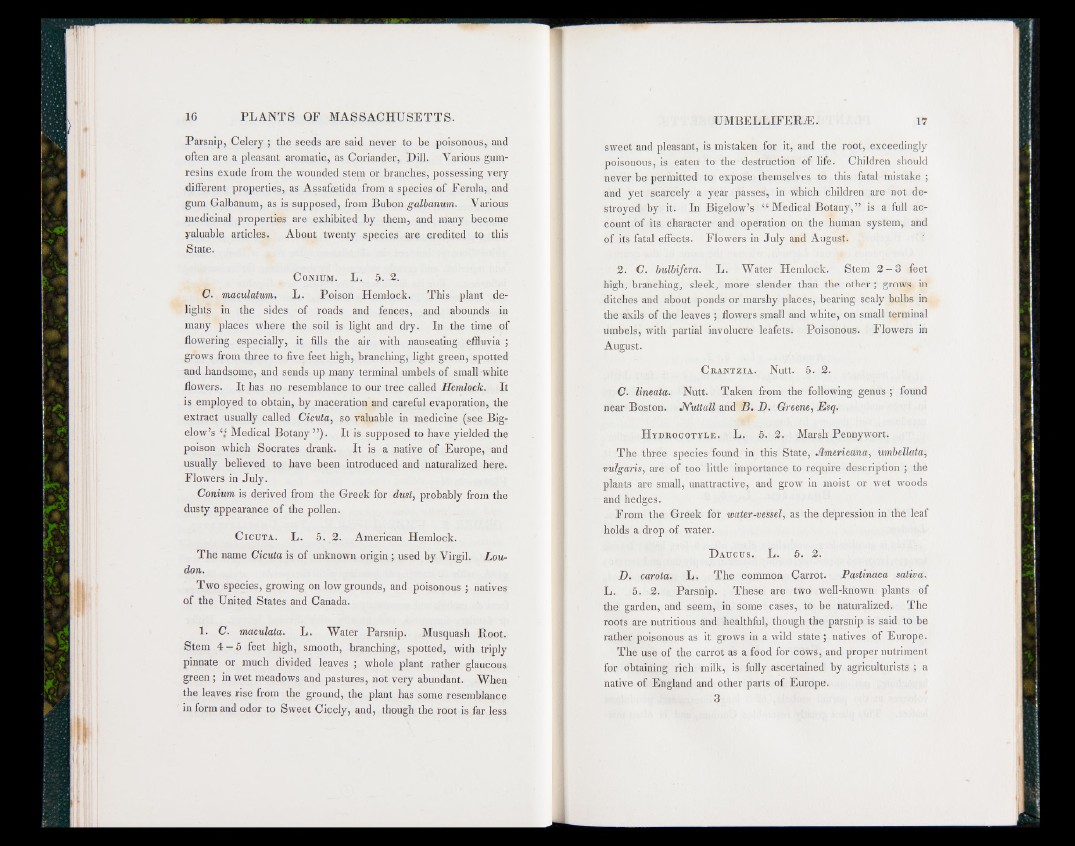
Parsnip, Celery ; the seeds are said never to be poisonous, and
often are a pleasant aromatic, as Coriander, Dill. Various gum-
resins exude from the wounded stem or branches, possessing very
different properties, as Assafostida from a species of Ferula, and
gum Galbanum, as is supposed, from Bubon galbanum. Various
medicinal properties are exhibited by them, and many become
valuable articles. About twenty species are credited to this
State.
C onium. L. 5. 2.
C. maculatum. L. Poison Hemlock. This plant delights
in the sides of roads and fences, and abounds in
many places where the soil is light and dry. In the time of
flowering especially, it fills the air with nauseating effluvia ;
grows from three to five feet high, branching, light green, spotted
and handsome, and sends up many terminal umbels of small white
flowers. It has no resemblance to our tree called Hemlock. It
is employed to obtain, by maceration and careful evaporation, the
extract usually called Cicuta, so valuable in medicine (see Bigelow’s
“ Medical Botany” ). It is supposed to have yielded the
poison which Socrates drank. It is a native of Europe, and
usually believed to have been introduced and naturalized here.
Flowers in July.
Conium is derived from the Greek for dust, probably from the
dusty appearance of the pollen.
C icuta. L. 5. 2. American Hemlock.
The name Cicuta is of unknown origin ; used by Virgil. Loudon.
Two species, growing on low grounds, and poisonous ; natives
of the United States and Canada.
1. C. maculata. L. Water Parsnip. Musquash Root.
Stem 4 - 5 feet high, smooth, branching, spotted, with triply
pinnate or much divided leaves ; whole plant rather glaucous
green ; in wet meadows and pastures, not very abundant. When
the leaves rise from the ground, the plant has some resemblance
in form and odor to Sweet Cicely, and, though the root is far less
sweet and pleasant, is mistaken for it, and the root, exceedingly
poisonous, is eaten to the destruction of life. Children should
never be permitted to expose themselves to this fatal mistake ;
and yet scarcely a year passes, in which children are not destroyed
by it. In Bigelow’s “ Medical Botany,” is a full account
of its character and operation on the human system, and
of its fatal effects. Flowers in July and August.
2. C. bulbifera. L. Water Hemlock. Stem 2 — 3 feet
high, branching, sleek, more slender than the other ; grows in
ditches and about ponds or marshy places, bearing scaly bulbs in
the axils of the leaves ; flowers small and white, on small terminal
umbels, with partial involucre leafets. Poisonous. Flowers in
August.
C rantzia. Nutt. 5. 2.
C. lineata. Nutt. Taken from the following genus ; found
near Boston. Nuttall and B . D. Greene, Esq.
H vdrocotyle. L. 5. 2. Marsh Pennywort.
The three species found in this. State, Americana, umbellata,
vulgaris, are of too little importance to require description ; the
plants are small, unattractive, and growr in moist or wet woods
and hedges.
From the Greek for water-vessel, as the depression in the leaf
holds a drop of water.
D aucus. L. 5. 2.
H. carota. L. The common Carrot. Pastinaca sativa.
L. 5. 2. Parsnip. These are two well-known plants of
the garden, and seem, in some cases, to be naturalized. The
roots are nutritious and healthful, though the parsnip is said to be
rather poisonous as it grows in a wild state ; natives of Europe.
The use of the carrot as a food for cows, and proper nutriment
for obtaining rich milk, is fully ascertained by agriculturists ; a
native of England and other parts of Europe.
3